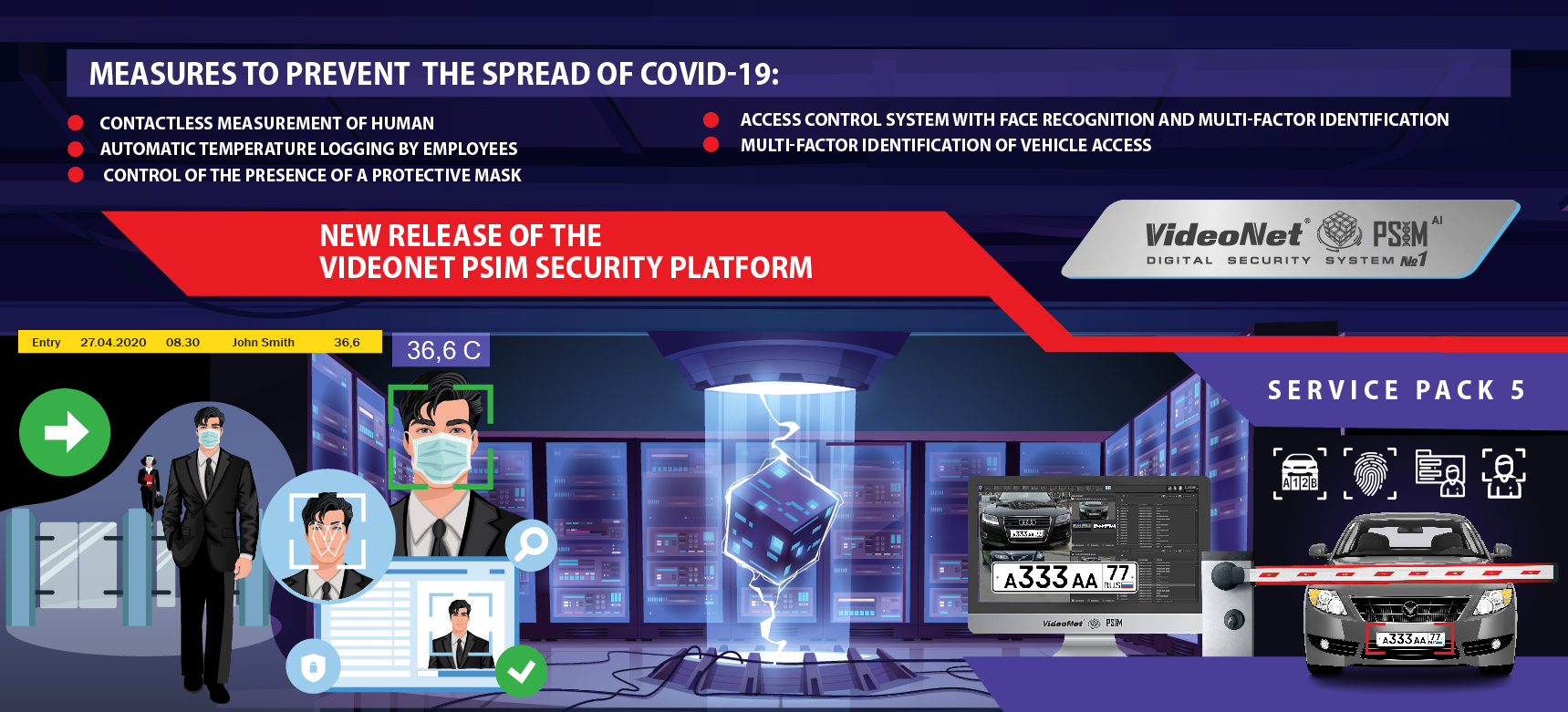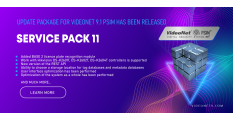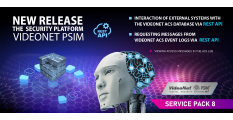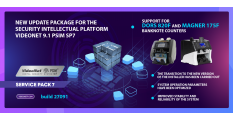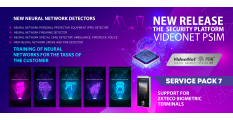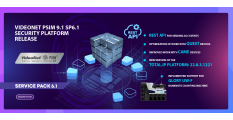We present the release of the VideoNet PSIM security platform - new features of the face recognition module for contactless employee access to the facility, new scenarios for multi-factor identification, countermeasures against the spread of COVID-19, support for breathalyzers, new reports, and increased security when working with data and the platform.
New functionality:
- Contactless employee access and time tracking based on a recognized face.
- Various access scenarios - multi-factor identification with face recognition, warning about face mismatch to the key.
- Multi-factor identification of vehicle access - vehicle licence plate, access card.
- Measures to counter the spread of COVID-19:
- contactless measurement of human temperature,
- AUTOMATIC temperature logging by employees,
- control of the presence of a protective mask.
- Added support for “Alcobarrier” breathalyzer.
- Updated neural network detectors. A new neural network with higher accuracy and recognition speed has been implemented.
- Creating tags on live video, in an archive, in a log.
- "Movement of cars on the territory" analytical report
- Optimization of storage of ACS data in VideoNet.
- “Alcohol test results” analytical report
- Increased security level when working with data.
- Optimization of functionality and improving the usability of the platform.
- Added new equipment - BPS M5, BPS C4 banknote counting machines.
Measures to counter the spread of COVID-19
The new functionality of VideoNet PSIM helps to identify violations of sanitary and epidemiological requirements and ensure safe working conditions for employees while the risk of the spread of coronavirus infection persists.
- contactless measurement of human temperature
- AUTOMATIC temperature logging by employees
- Blocking the passage point when the set temperature threshold is exceeded
- Determination of the absence of a mask on the face
- Crowd detection
- Contactless access to the facility by the recognized face
Contactless measurement of human temperature
To organize remote measurement of human temperature, thermographic cameras can be added to the VideoNet PSIM platform configuration. VideoNet PSIM integrates the best thermographic cameras on the market, which measure a person's temperature in less than 1 second with a minimum measurement error.
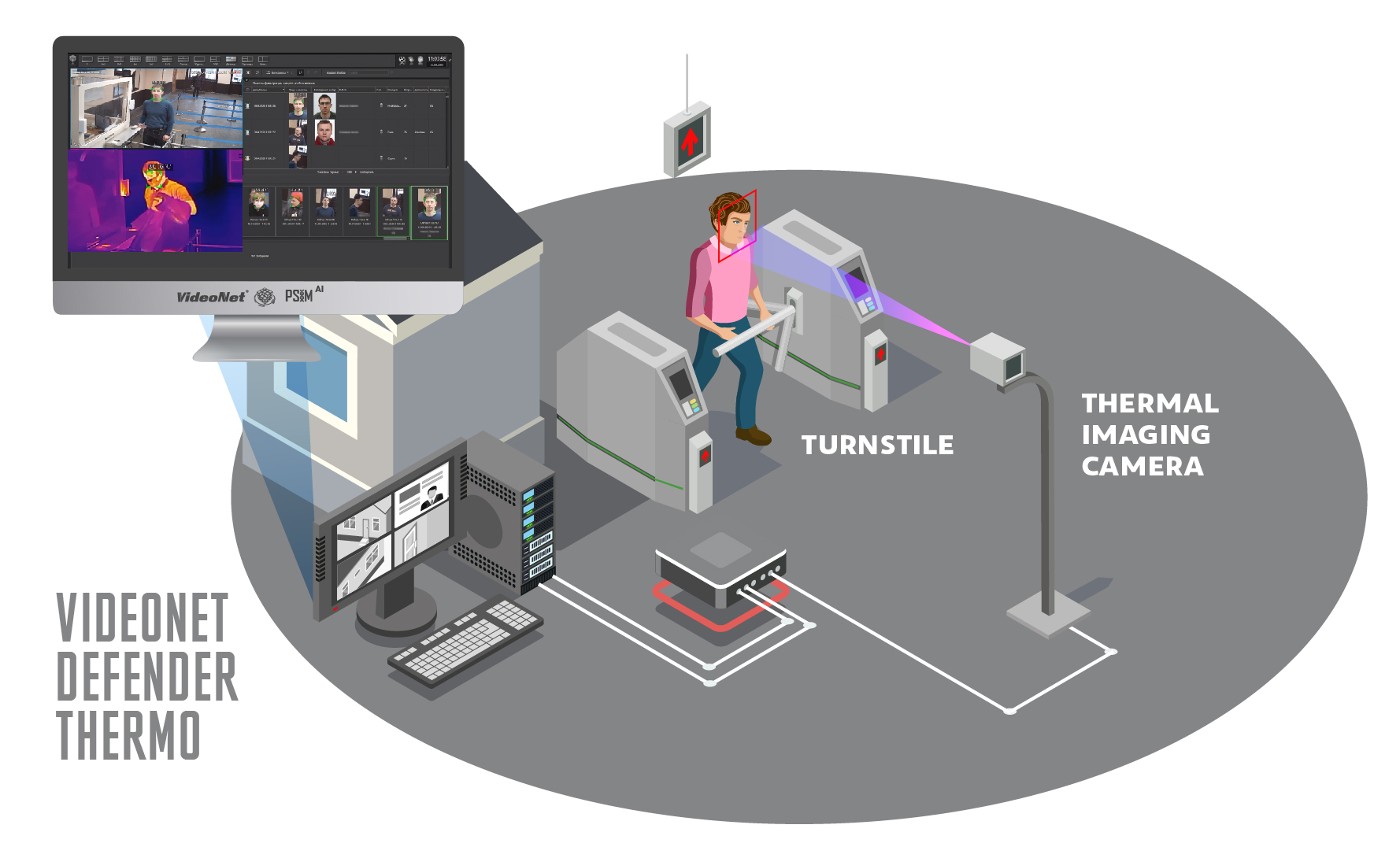
The joint work of the face recognition module in VideoNet and a special algorithm for obtaining data on the temperature of a specific person from a thermographic camera allows you to personalize the measurement result and automatically keep a log with data saving for subsequent analysis in the format: Date - Time - Surname - Photo - Temperature. Temperature measurement results and person identification are displayed on video in real time and stored in the archive.
When a person with an elevated body temperature is detected, VideoNet PSIM will automatically restrict his access to the facility due to the automatic control of the access control and management system, will give an alarm or notification about the fact that a particular employee has an elevated temperature.

The automatic temperature measurement functionality effectively solves the problem of remote temperature control and prevents crowds and delays in accessing the object.
Determination of the absence of a mask:
The functionality allows you to monitor compliance with the established rules when visiting the facility and informs about the absence of personal face protective equipment for employees and visitors.
Determination of the presence or absence of a mask on a face is based on a neural network face recognition algorithm. All results of determining the absence or presence of a mask can be seen in the "Faces" Log and further use the data to take action against violators.
When configuring online notifications, you can select one of the following values for the Mask parameter:
- absent;
- medical mask;
- balaclava;
- mask (without type);
- any
Individual notification scenarios can be configured for different values of the "Mask" parameter: sound signal, sending notifications to email or sms, sending an alarm event to the event panel, sending a screenshot, recording by a selected camera, etc.
Access control system with face recognition and multi-factor identification
VideoNet PSIM implements multi-factor scenarios for employees' access to the facility and premises.
For different passage points, you can choose your own access option, configure: contactless access by face, two-factor identification, warn about the mismatch between the face and the cardholder. Regardless of the selected scenarios and their combinations, all ACS reports and time tracking reports are available for different passage points.
You can individually configure the access scenario for each passage point:
- contactless access by face;
- by key;
- by key and face (first the key needs to be submitted);
- by face and key (first the face needs to be recognized);
- any (key+face);
- by key or face.
To solve the problem of transferring the access card to another employee or third party, the functionality of detecting the mismatch between the person and the cardholder is implemented. When the card is held up to the reader, the person who attached the access card is identified and compared with the cardholder's face. When a card transfer is detected, various notification options are available, depending on the regulations adopted by the company's security service.
In the context of a pandemic, the use of a contactless access control system with employee face identification becomes an effective solution. The introduction of a contactless access control system with face recognition at checkpoints reduces the risk of infection, eliminates direct physical contact of the employee with the reader or terminal, and there is no need to disinfect the reader every time to comply with sanitary standards.
Multi-factor identification of vehicle access
To organize vehicle access to the facility, you can now use identification based on several attributes - the licence plate and access card.
You can individually configure the access scenario for each access gate point:
- by licence plate;
- by key;
- by key and licence plate;
- by licence plate and key;
- any (key+licence plate);
- by key or licence plate..
“Movement of cars on the territory” analytical report
“Movement of cars on the territory” analytical report allows you to view data about the movement of cars on the territory of the facility.
The report displays the information about the car’s entry/departure through the access gate points and also specifies the date and time.
Optimization of storage of ACS data in VideoNet
In order to increase the level of security when working with ACS data, the reliability of their storage and improve the performance of the platform, various scenarios for working with ACS data are implemented:
- Separation of ACS databases for branches or geographically remote divisions within one organization. For each department or branch, you can create a separate ACS server with its own ACS database. This option is especially relevant when using multifactor identification, when a stable connection with the ACS database is required to make a decision on admission to an object.
- Choosing a storage location for ACS databases on strictly defined VideoNet servers. You can designate a server that will store the ACS database and assign rights to access this server.
- Ensuring the security of ACS data of different enterprises or legal entities, whose objects are protected by one VideoNet network. For each enterprise it is possible to organize a separate ACS server with access to the ACS data only for the employees of the given enterprise.
Support for “Alcobarrier” breathalyzer
The “Alcobarrier” breathalyzer is supported for automatic analysis of exhaled air for alcohol. For the access point, in the “Special capabilities” pane, select “Testing for alcohol”. An employee's admission to the object is carried out if the received value per mille is lower than the specified one.
The joint work of the “Alcobarrier” breathalyzer is implemented with all ACS controllers supported in VideoNet: Quest, Bolid, Hikvision, Gate.
For the selected time interval, you can build an analytical report "Alcohol test results" with a given per mille value. The report will contain a list of employees with fields:
- Date and time;
- Per mille;
- Access point;
- Employee;
- Employee ID;
- Department;
- Position.

Updated neural network detectors
At the heart of neural network detectors for determining the object types and queues (crowds of people), a third-generation neural network is implemented. The neural network provides faster and more accurate identification of objects in the frame. Support for identifying the following types of objects is implemented: man, car, bus, motorcycle, bicycle, dog, train and plane. The accuracy of recognition of object types is not affected by weather conditions, change of time of day, illumination, etc.
Advantages of using a new neural network as part of detectors:
- Improving the accuracy of object recognition of all three types of neural networks (big, medium, standard).
- New standard-size neural network, in contrast to the old one, provides a higher number of frames per second (FPS) on similar equipment and has a higher accuracy of object recognition.
- Reducing system requirements for using a big neural network. To use a big neural network, the requirements for the amount of memory on the video card are reduced to 4GB.
- All three neural networks are now installed during VideoNet installation. Additional module installation is no longer required.
Creating tags
The universal tag creating mechanism allows you to add tags to live video in a video window, in an archive, in an event log or event panel, at an access point or access gate point, in a POS window. Tags can be edited and deleted.
The user, having noticed an abnormal event, clicks on the button for creating a tag, adds a description of the event, for example, "Fight in the warehouse", "Fall of a person", "Suspicious activity", the date and time of the event are recorded. If necessary, you can add a detailed description of the event.
The universal tag creating mechanism makes it easier to search video archives and makes the security system more efficient. All tags are saved in the tags window and help you quickly find and view the desired event.
Optimization and improving the usability of the platform
- When generating the report “Moving of employees on the site”, the ability to set a time interval with an accuracy of up to a minute was added.
- Added import of screen modes and the ability to save selected screen modes when updating.
- In the analytical report "Arrival and departure of employees" the ability to build a report for the selected time interval - date + time - and the ability to sort by any column of the report was added.
- Now you can completely change the composition and size of the submode windows when creating screen submodes. By default, the submode inherits all the properties of the parent mode, now you can change the type, number, size and position of windows. Adding and removing windows is also available. The submode is useful in cases, where for a mode with the same set of windows, different sources must be specified or a slightly different set of windows is needed.
- Added the ability to save and print a photo of a recognized face from the "Faces" log.
- Added setting of the detector frame thickness when displaying detectors in the video window.
- Added the "Record deletion" event. The event is added to the Access to the archive log, which contains all events related to the archive operation. You can filter and sort for each of the log columns. When an event occurs, the system can automatically respond according to predefined reactions and notifications.
- Now there is a simple way to send notifications to email without creating a reaction to the event. Now the user can activate sending an e-mail by checking the box in Events. For example, when a message appears in the log "The operator has deleted a fragment", automatically notify the head of security by e-mail.
- Improved calling of help when working with the program using the F1 button. The linking of help sections by pages and separate windows has been made.
Increased security level when working with data
- Differentiation of access rights for employees in the ACS environment for assigning keys - the ability to add and remove keys to employees; assignment of access groups - the ability to assign access groups to employees and departments; editing time tracking - setting working hours for an employee.
- Creation of a report on the list of rights granted to VideoNet users. The report displays the granted/permissive rights. The report is relevant for large and distributed systems, when you need to understand what cameras, devices, functionality a specific user has access to. The report can be printed or saved in one of the following file formats: PDF; CSV; HTML; RTF; XLS; XLSX.
- Introduced mandatory user authorization when creating a backup copy of the VideoNet configuration using the backup and restore configuration utility.

